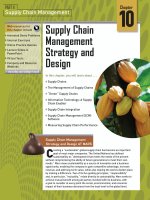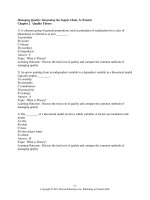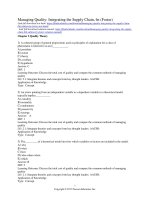Lecture Operations management: Creating value along the supply chain (Canadian edition) - Chapter 16
Bạn đang xem bản rút gọn của tài liệu. Xem và tải ngay bản đầy đủ của tài liệu tại đây (682.64 KB, 55 trang )
OPERATIONS MANAGEMENT:
Creating Value Along the Supply Chain,
Canadian Edition
Robert S. Russell, Bernard W. Taylor III, Ignacio Castillo, Navneet Vidyarthi
CHAPTER 16
Lean Systems
6-1
Learning Objectives
Basic Elements of Lean Production
Benefits of Lean Production
Implementing Lean Production
Lean Services
Leaning the Supply Chain
Lean Six Sigma
Lean and the Environment
Value Stream Mapping
6-2
Lean Production
Doing more with less inventory, fewer workers,
less space
Just-in-time (JIT)
smoothing the flow of material to arrive just as it is
needed
“JIT” and “Lean Production” are used interchangeably
Muda
waste, anything other than that which adds value to
product or service
6-3
Seven Wastes in Operations
6-4
Seven Wastes in Operations
6-5
Seven Wastes in Operations
6-6
Basic Elements
1.
2.
3.
4.
5.
11.
12.
13.
14.
Flexible resources
Cellular layouts
Pull system
Kanbans
Small lots
Quick setups
Uniform production levels
Quality at the source
Total productive
maintenance
15. Supplier networks
6-7
Flexible Resources
Multifunctional workers
perform more than one job
general-purpose machines perform several basic
functions
Cycle time
time required for the worker to complete one pass
through the operations assigned
Takt time
paces production to customer demand
6-8
Standard Operating Routine
for a Worker
6-9
Cellular Layouts
Manufacturing cells
comprised of dissimilar machines brought together to
manufacture a family of parts
Cycle time is adjusted to match takt time by
changing worker paths
6-10
Cells With Worker Routes
6-11
Worker Routes Lengthen
as Volume Decreases
6-12
Pull System
Material is pulled through the system when needed
Reversal of traditional push system where material
is pushed according to a schedule
Forces cooperation
Prevent over and underproduction
While push systems rely on a predetermined
schedule, pull systems rely on customer requests
6-13
Kanbans
Card which indicates standard quantity of
production
Derived from two-bin inventory system
Maintain discipline of pull production
Authorize production and movement of goods
6-14
Sample Kanban
6-15
Origin of Kanban
a) Two-bin inventory system
b) Kanban inventory system
Bin 1
Kanban
Bin 2
Reorder
card
Q-R
R
R
Q = order quantity
R = reorder point = demand during lead time
6-16
Origin of Kanban
a) Two-bin inventory
b) Kanban inventory
system:
system:
Order of size Q is placed
Bin 1 has been
when Bin 1 is empty, i.e., eliminated, i.e., there is
reorder point is reached
always an order in
(see also EOQ)
transit
Reorder point
corresponds to lead time Q-R inventory
eliminated. i.e.,
demand
When shipment arrives
inventory levels have
Bin 1 and Bin 2 are
been significantly
empty and will be refilled reduced
6-17
Dual Kanban System
Production kanban
authorizes production of goods
Withdrawal kanban
authorizes movement of goods
6-18
Other Kanbans
Kanban square
a marked area
designated to hold items
Kanban rack
allocated slots to hold
items
6-19
Other Kanbans
Signal kanban
a triangular kanban used to signal
production at the previous
workstation
Kanban post office holding:
Material kanbans
used to order material in advance of a process
Supplier kanbans
rotates between the factory and suppliers
6-20
Determining Number of Kanbans
No. of Kanbans =
average demand during lead time + safety stock
container size
N =
where
dL + S
C
N
d
L
S
= number of kanbans or containers
= average demand over some time period
= lead time to replenish an order
= safety stock, usually given as percentage
of demand during lead time
C = container size
6-21
Determining Number of Kanbans
d
L
S
C
= 150 bottles per hour
= 30 minutes = 0.5 hours
= 0.10(150 x 0.5) = 7.5
= 25 bottles
(150 x 0.5) + 7.5
dL + S
N=
=
C
25
75 + 7.5
=
= 3.3 kanbans or containers
25
Round up to 4 (to allow some slack) or
down to 3 (to force improvement)
6-22
Small Lots
Require less space and capital investment
Move processes closer together
Make quality problems easier to detect
Make processes more dependent on each other
6-23
Inventory Hides Problems
High inventory (= water) levels hide problems (= rocks) and
allow for smooth sailing
6-24
Less Inventory Exposes Problems
Forcing inventory (= water) levels down exposes problems
(= rocks) which then must be removed
6-25









